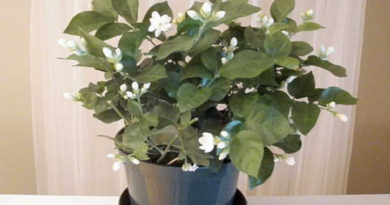How Often Do Orchids Bloom? When to Expect Flowers
Orchids are some of the most notoriously popular houseplants, and for good reason. They are simply enchanting when in bloom. Most often, we purchase orchids while they have flowers on them. How else would they capture our attention if not for their unique and magnificent flowers?
It can be confusing to think about these tropicals as having a season. How can you always find them for sale in bloom if they flower seasonally? There is a reasonable answer to this, and as you read on, you will likely figure out how it’s done.
We will focus on encouraging your orchid to flower on its usual schedule, though, since that is when it will occur most naturally. If you pay attention to its needs, you will know exactly what to do to help initiate the flowering process. So, just how often do they bloom, and when should you expect to see some flowers? Let’s dig in.
The Short Answer
Most orchids flower once or twice per year. The timing and frequency with which your orchid will bloom depends on several factors. The type of orchid and its location are determining factors. Environmental factors also influence bloom time and frequency. Shifts in light and temperature trigger flower development in most species. Orchids are heavy feeders, so they also respond well to frequent fertilizing.
The Long Answer


Convincing your orchid to bloom is something of an art and requires understanding your specific plant and its habits. There are types that flower during every part of the year. I’m here to talk about when to expect your plant to bloom and what it needs to get there.
What Type of Orchid Do I Have?


With around 28,000 species of orchids in the world, it stands to reason that they don’t all have exactly the same habits. Some are spring bloomers, some are fall bloomers, and others can flower anytime. Some species bloom only once yearly, others twice yearly. Still, others can be continuous bloomers that flower more often than this.
Let’s break that number down a bit and look at blooming in terms of genera. There are nearly 900 genera of orchids, each with their differences, though some are subtle. They are native to a wide range of locations and climates. Most are native to rainforest climates, but some species grow in every state in the United States.
Most of the orchids kept as houseplants are tropical. Some of the most common types you will find from retailers include phalaenopsis, dendrobium, oncidium, cattleya, epidendrum, cymbidium, brassavola, miltonia, zygopetalum, laelia, and spathoglottis. You can take a look at this article for an in-depth look at many types of orchids. It will help you determine which one you are working with.
When Does My Orchid Bloom in the Wild?


It would be impossible to discuss the flowering habits of all species, so I will stick to those types we commonly keep as houseplants. Bear in mind that this list is far from exhaustive and only indicates when these plants bloom in their native environment.
Amount of Blooms and Seasonality Based on Genus
| Genus | Frequency of Blooms | Season |
| Phalaenopsis | 1-3 times | Winter, Spring |
| Dendrobium | 1-2+ | All |
| Oncidium | 2-3 | Fall, Spring (some hybrids year-round) |
| Cattleya | 1-2 | Spring and Summer (more often in a greenhouse) |
| Epidendrum | 2+ | Spring, Summer, Fall |
| Cymbidium | 1-2+ | Fall, Winter, Spring |
| Brassavola | 1-2 | Spring, Fall, Winter |
| Miltonia | 1-2 | Spring, Fall |
| Zygopetalum | 1-2 | Spring, Fall |
| Vanda | 2-3 | All |
| Laelia | 1 | Fall, Winter |
| Spathoglottis | 2-3 | All |
What Factors Influence or Encourage Blooming?


We will focus on spring blooming as a good target as we discuss the factors involved in initiating that cycle. If we aim for a spring bloom, we need to initiate the cycle in the fall.
Considering natural seasonal shifts makes it much clearer why and how various elements affect the cycle. Let’s look at adjusting our plant’s environment to initiate flowering.
Time of Year


The plant’s natural habit plays a starring role in its cultivation behavior to a large degree. The closer you can mimic the conditions of its native environment, the better. This helps the plant align its habits with the time of year and conditions it has evolved to follow.
Recreating a tropical environment in your home can be challenging, so we do our best. Then, we can observe how the plant adapts and make adjustments where necessary.
That said, cultivated orchids can flower on the same schedules and, sometimes, more often than those in the wild. If we provide the right conditions, we have more control over their bloom times.
Light


Providing your plant with the right type and amount of sunlight is paramount to blooming. Most orchids don’t like direct sun, but they need quite a lot of light to flower. Knowing what type of plant you have is also important.
Some types, like phalaenopsis, prefer lower light conditions. They do very well indoors as a result. Others, like cattleyas and vandas, prefer some direct light or bright, indirect exposure all day. As a general rule, most orchids prefer bright, indirect light for most of the day.
So, how will you know if your plant is getting enough light? That’s pretty simple, really. Look at the leaves. Orchid leaves should be stiff and stand upright. They should be a mid-shade of yellowish green rather than dark green.
If your plant produces abundant dark green growth but shows no indication of flowering, it’s not getting enough sun. Too much sun is usually the culprit if your orchid leaves look bleached or scorched.
Another light-related factor in the flowering process is the length of daylight. Plants need to experience light cycles, and the duration and arrangement of these cycles often tell a plant when it’s time to start producing flowers.
Ultimately, there is a clear path to optimal blooming but you can start by ensuring your orchid gets as much natural light as it needs. The natural cycles of sunlight and darkness will let the plant know when to initiate flowering.
Temperature


Orchids are typically comfortable in temperatures similar to those humans tend to set their thermostats to. Some, like vandas, prefer warmer weather, so they don’t make great houseplants.
Many orchids are spring bloomers, and we can use this information to understand how temperature drops affect the process. Shorter days and cooler nights tell these plants that it’s time to begin forming a spike.
A drop of about 10 degrees at night is right where you want to be. Now, how do you do that in a house with the thermostat set to a specific temperature? Well, it depends on how much effort you want to put in.
A simple way to give your orchids a natural temperature drop is to place them outdoors. Aim for nighttime temperatures in the 55-65°F (13-18°C) range. Pay close attention to the weather because a frost can kill your plant. The plant needs a perceptible shift between day and night temperatures of about 15 degrees for two to three weeks.
This shift will let the plant know it’s time to begin flowering. After exposing it to fluctuating day and night temperatures, you can return it to the indoors and resume your usual care routine. While it is outdoors, you’ll want to increase your watering frequency slightly.
Nutrients


The final piece of this puzzle is your orchid’s rather significant nutrient needs. Applying fertilizer will not initiate flowering; consistent nutrients build a healthier plant over time.
These tropical beauties need fertilizer regularly to keep them healthy. They will thrive with applications of fertilizer one to two times per month. They need regular application because their potting medium lacks water or nutrients.
If they consistently get enough nutrients, they will have plenty of energy when the light and temperature shifts signal the flowering process. Continue to fertilize until the flowers drop.
Key Takeaways
The best way to encourage these beauties to bloom is to mimic the shifts of their natural environment. They have adapted to these conditions over long periods of time. Your orchid will flower best when its internal clock says that the time is right!





